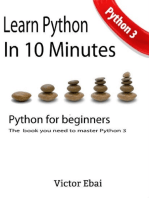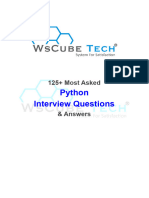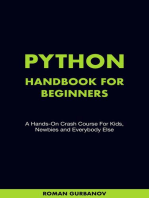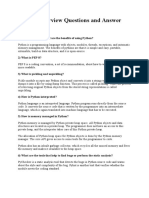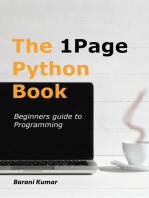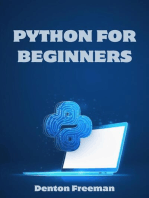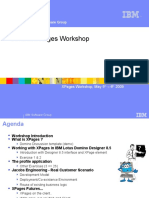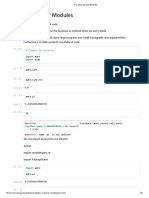0 ratings0% found this document useful (0 votes)
7 viewsPython Slip Test
Python is an interpreted, object-oriented, high-level programming language widely used in web development and machine learning. Key features include easy syntax, dynamic typing, and support for multiple programming paradigms. The document also outlines Python's principles, keywords, and provides example programs for checking Armstrong numbers and reversing a number.
Uploaded by
Ruchita MaaranCopyright
© © All Rights Reserved
We take content rights seriously. If you suspect this is your content, claim it here.
Available Formats
Download as DOCX, PDF, TXT or read online on Scribd
0 ratings0% found this document useful (0 votes)
7 viewsPython Slip Test
Python is an interpreted, object-oriented, high-level programming language widely used in web development and machine learning. Key features include easy syntax, dynamic typing, and support for multiple programming paradigms. The document also outlines Python's principles, keywords, and provides example programs for checking Armstrong numbers and reversing a number.
Uploaded by
Ruchita MaaranCopyright
© © All Rights Reserved
We take content rights seriously. If you suspect this is your content, claim it here.
Available Formats
Download as DOCX, PDF, TXT or read online on Scribd
You are on page 1/ 4
1. What is Python Programming Language?
Ans: Python is an interpreted, object-oriented, high-level programming
language with dynamic semantics.
Python is a high-level, general-purpose, and very popular programming
language.
Python programming language (latest Python 3) is being used in web
development, and Machine Learning applications, along with all cutting-edge
technology in Software Industry.
There are two major Python versions: Python 2 and Python 3.
2. What can Python do?
Ans:
Python can be used on a server to create web applications.
Python can be used alongside software to create workflows.
Python can connect to database systems. It can also read and modify
files.
Python can be used to handle big data and perform complex
mathematics.
Python can be used for rapid prototyping, or for production-ready
software development.
3. What is the main concept of Python?
Ans: Python has a simple syntax similar to the English language.
Python has syntax that allows developers to write programs with fewer lines
than some other programming languages.
Python runs on an interpreter system, meaning that code can be executed as
soon as it is written.
This means that prototyping can be very quick.
4. What are the 5 features of Python?
Ans: Python is easy to learn and use, object-oriented, interpreted, cross-
platform, has an extensive standard library, is dynamically typed, supports
multiple programming paradigms, is free and open source, and supports
databases and GUI programming.
5. What are the 4 pillars of Python?
Ans: The 4 pillars of object-oriented programming (OOP) in Python (and
generally in programming) are:
Encapsulation: Bundling data (attributes) and methods (functions) that
operate on the data into a single unit (class).
Abstraction: Hiding complex implementation details and providing a simplified
interface.
Inheritance: Allowing a class to inherit attributes and methods from another
class, promoting code reuse.
Polymorphism: Using a single interface to represent different data types or
objects.
6. What are the 5 Python principles?
Single-responsibility principle (SRP)
Open–closed principle (OCP)
Liskov substitution principle (LSP)
Interface segregation principle (ISP)
Dependency inversion principle (DIP)
7. Write any 10 keywords in Python?
Ans: if, else, for, while, def, class, import, return, True, and False.
8. What are Python features?
9. Write a Python Program to check Armstrong Number.
num = int(input("Enter a number: "))
order = len(str(num))
sum = 0
temp = num
while temp > 0:
digit = temp % 10
sum += digit ** order
temp //= 10
if num == sum:
print(num,"is an Armstrong number")
else:
print(num,"is not an Armstrong number")
10. Write a Python Program to Reverse a Number.
num = int(input("Enter a number: "))
reversed_num = 0
while num != 0:
digit = num % 10
reversed_num = reversed_num * 10 + digit
num //= 10
print("Reversed Number: " + str(reversed_num))
You might also like
- 300 Python Interview Questions and Solutions100% (1)300 Python Interview Questions and Solutions88 pages
- Python Programming For Beginners: Python Programming Language TutorialFrom EverandPython Programming For Beginners: Python Programming Language TutorialNo ratings yet
- Python Interview Questions Answers Free PDFNo ratings yetPython Interview Questions Answers Free PDF16 pages
- Python Programming: Your Beginner’s Guide To Easily Learn Python in 7 DaysFrom EverandPython Programming: Your Beginner’s Guide To Easily Learn Python in 7 Days2.5/5 (3)
- Python Simplified: Learn Programming Through Practical ExamplesFrom EverandPython Simplified: Learn Programming Through Practical ExamplesNo ratings yet
- LEARN PYTHON PROGRAMMING: A Comprehensive Guide for Beginners to Master Python Programming (2024)From EverandLEARN PYTHON PROGRAMMING: A Comprehensive Guide for Beginners to Master Python Programming (2024)No ratings yet
- Python Handbook For Beginners. A Hands-On Crash Course For Kids, Newbies and Everybody ElseFrom EverandPython Handbook For Beginners. A Hands-On Crash Course For Kids, Newbies and Everybody ElseNo ratings yet
- Mastering Python Programming: A Comprehensive Guide: The IT CollectionFrom EverandMastering Python Programming: A Comprehensive Guide: The IT Collection5/5 (1)
- Elaborate All Questions From First to Last on Firs...No ratings yetElaborate All Questions From First to Last on Firs...4 pages
- PYTHON FOR BEGINNERS: Master the Basics of Python Programming and Start Writing Your Own Code in No Time (2023 Guide for Beginners)From EverandPYTHON FOR BEGINNERS: Master the Basics of Python Programming and Start Writing Your Own Code in No Time (2023 Guide for Beginners)No ratings yet
- Top 25 Python Programming Viva QuestionsNo ratings yetTop 25 Python Programming Viva Questions4 pages
- Mastering Python: A Comprehensive Guide for Beginners and ExpertsFrom EverandMastering Python: A Comprehensive Guide for Beginners and ExpertsNo ratings yet
- Python Questions for Cloudy Coders DriveNo ratings yetPython Questions for Cloudy Coders Drive28 pages
- PYTHON DATA SCIENCE FOR BEGINNERS: Unlock the Power of Data Science with Python and Start Your Journey as a Beginner (2023 Crash Course)From EverandPYTHON DATA SCIENCE FOR BEGINNERS: Unlock the Power of Data Science with Python and Start Your Journey as a Beginner (2023 Crash Course)No ratings yet
- Python Interview Questions: Answer: in Duck Typing, One Is Concerned With Just Those Aspects of An Object That AreNo ratings yetPython Interview Questions: Answer: in Duck Typing, One Is Concerned With Just Those Aspects of An Object That Are12 pages
- Practical Guide to Python: From Basics to Advanced ProgrammingFrom EverandPractical Guide to Python: From Basics to Advanced ProgrammingNo ratings yet
- python programming question bank unit wise by Rupesh ✓No ratings yetpython programming question bank unit wise by Rupesh ✓24 pages
- PYTHON FOR BEGINNERS: A Comprehensive Guide to Learning Python Programming from Scratch (2023)From EverandPYTHON FOR BEGINNERS: A Comprehensive Guide to Learning Python Programming from Scratch (2023)No ratings yet
- Methods of The Assessment of Learning Outcomes and Graduate Attributes Followed at SIMATSNo ratings yetMethods of The Assessment of Learning Outcomes and Graduate Attributes Followed at SIMATS9 pages
- Introduction To Date and Calendar Utilities in JavaNo ratings yetIntroduction To Date and Calendar Utilities in Java7 pages
- Programming With Java For Language Developers Csa0711No ratings yetProgramming With Java For Language Developers Csa071113 pages
- SAP BAPI Tutorial - Step by Step Guide To Create BAPI in ABAPNo ratings yetSAP BAPI Tutorial - Step by Step Guide To Create BAPI in ABAP5 pages
- CP7301 Software Process and Project Management Question Banks Annaunivhub - Blogspot.inNo ratings yetCP7301 Software Process and Project Management Question Banks Annaunivhub - Blogspot.in7 pages
- Certificate Program in Full Stack Development With SpecializationNo ratings yetCertificate Program in Full Stack Development With Specialization25 pages
- Domino Xpages Workshop: Ibm Software GroupNo ratings yetDomino Xpages Workshop: Ibm Software Group56 pages
- Introduction To Agile and Scrum: Simon BakerNo ratings yetIntroduction To Agile and Scrum: Simon Baker73 pages
- Agile Israel Feature Driven Development: For The Agile Agent of ChangeNo ratings yetAgile Israel Feature Driven Development: For The Agile Agent of Change37 pages
- Scrum Process (3D Model) : Pre-Game Staging Sprint Development Sprints Wrapper SprintsNo ratings yetScrum Process (3D Model) : Pre-Game Staging Sprint Development Sprints Wrapper Sprints5 pages


